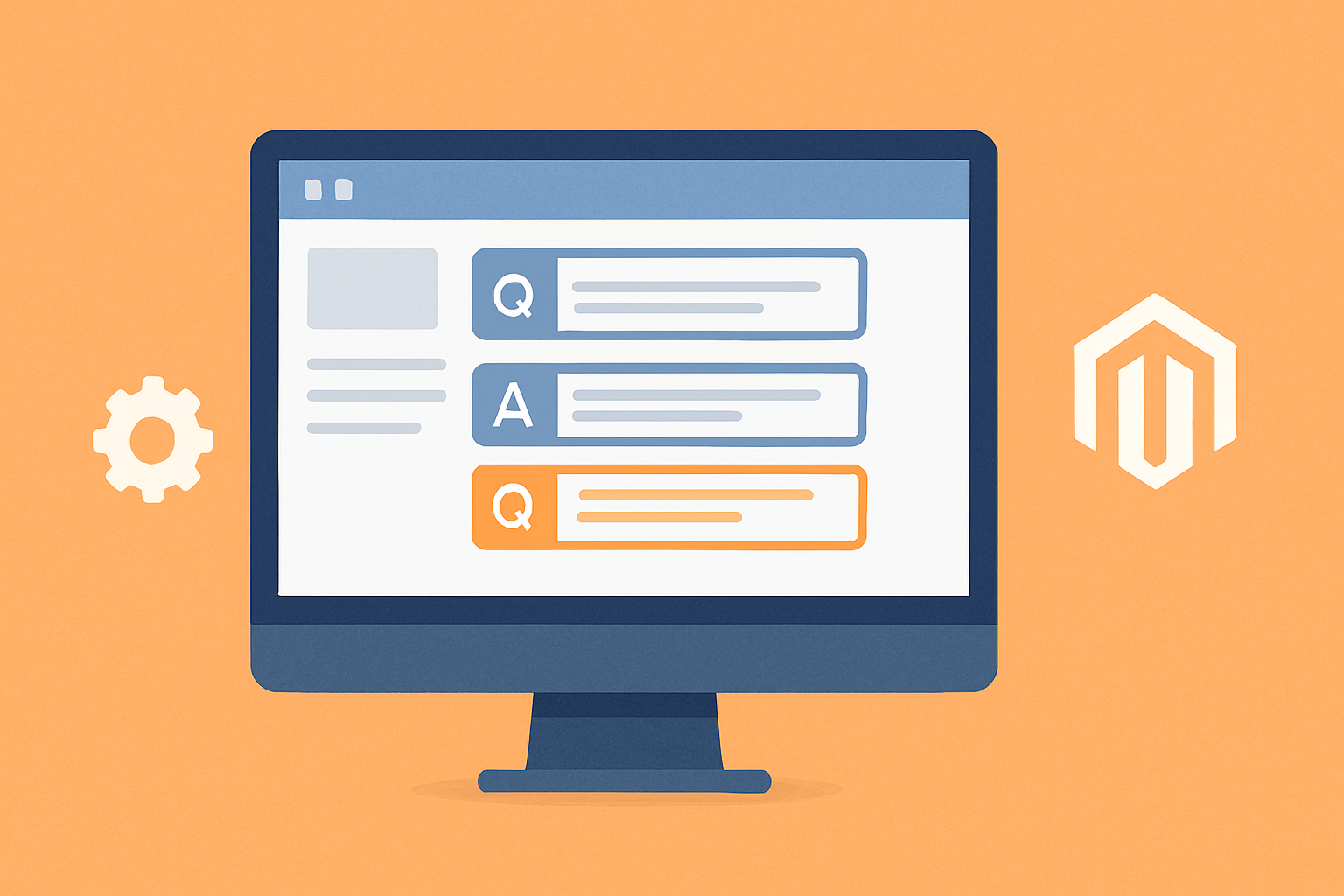How to Build a Custom "Product Q&A" Module in Magento 2

How to Build a Custom "Product Q&A" Module in Magento 2
Imagine this: a customer lands on a product page and has a specific question about sizing or compatibility. Instead of leaving the page or calling support, they ask directly under the product. Later, other shoppers find the question and answer useful — conversion increases, returns drop. That’s the value of an inline Product Q&A module in Magento 2.
In this post I’ll walk you through building a custom Product Q&A module step-by-step (code included). I’ll keep the tone friendly — like explaining to a teammate — and focus on clean architecture, frontend integration, admin moderation, SEO with Schema.org FAQ markup, and optional extensions such as email notifications and automated moderation. I’ll use Magefine as the vendor namespace so examples align with magefine.com.
Overview and architecture
High-level components we’ll implement:
- Database table(s) for questions (and optionally answers)
- Models, ResourceModels, and Collections
- Repository/Service layer for business logic
- Frontend controller endpoints (AJAX) to post questions and fetch lists
- Blocks/ViewModels and templates to render the Q&A on product pages
- Admin area: grid + form to moderate, approve, edit and answer questions
- JSON-LD output for Schema.org FAQPage per product
- Optional integrations: email notifications, automated moderation, spam protection
Module name: Magefine_ProductQa (Vendor: Magefine, Module: ProductQa). We'll keep code examples clear and ready to drop into a module skeleton.
Step 0 — Create module basic files
Create the folder app/code/Magefine/ProductQa and add these files:
// app/code/Magefine/ProductQa/registration.php
<?php
use Magento\Framework\Component\ComponentRegistrar;
ComponentRegistrar::register(
ComponentRegistrar::MODULE,
'Magefine_ProductQa',
__DIR__
);
// app/code/Magefine/ProductQa/etc/module.xml
<?xml version="1.0"?>
<config xmlns:xsi="http://www.w3.org/2001/XMLSchema-instance" xsi:noNamespaceSchemaLocation="urn:magento:framework:Module/etc/module.xsd">
<module name="Magefine_ProductQa" setup_version="1.0.0" />
</config>
After adding those files run bin/magento setup:upgrade and bin/magento setup:di:compile (if in production mode).
Step 1 — Database schema
Use declarative schema. We'll create a simple questions table. Each question can have an answer column, but you may prefer separate answer records for multiple answers or threads.
// app/code/Magefine/ProductQa/etc/db_schema.xml
<?xml version="1.0"?>
<schema xmlns:xsi="http://www.w3.org/2001/XMLSchema-instance" xsi:noNamespaceSchemaLocation="urn:magento:framework:Setup/Declaration/Schema/etc/schema.xsd">
<table name="magefine_productqa_question" resource="default" engine="innodb" comment="Product Q&A Questions">
<column xsi:type="int" name="question_id" unsigned="true" nullable="false" identity="true" comment="Question ID" />
<column xsi:type="int" name="product_id" unsigned="true" nullable="false" comment="Product ID" />
<column xsi:type="int" name="customer_id" unsigned="true" nullable="true" comment="Customer ID" />
<column xsi:type="text" name="question_text" nullable="false" comment="Question Text" />
<column xsi:type="text" name="answer_text" nullable="true" comment="Answer Text" />
<column xsi:type="smallint" name="status" nullable="false" default="0" comment="0=pending,1=approved,2=rejected" />
<column xsi:type="smallint" name="is_visible" nullable="false" default="1" comment="Visibility" />
<column xsi:type="timestamp" name="created_at" nullable="false" on_update="false" default="CURRENT_TIMESTAMP" />
<column xsi:type="timestamp" name="updated_at" nullable="true" on_update="true" />
<constraint referenceId="PRIMARY" xsi:type="primary" columns="question_id" />
<constraint xsi:type="foreign" referenceId="FK_MAGEFINE_QA_PRODUCT_ID" column="product_id" referenceTable="catalog_product_entity" referenceColumn="entity_id" onDelete="CASCADE" />
<index name="PRODUCT_ID" column="product_id" />
</table>
</schema>
Run setup:upgrade and Magento will create the table.
Step 2 — Model, ResourceModel, Collection
Minimal model structure:
// app/code/Magefine/ProductQa/Model/Question.php
<?php
namespace Magefine\ProductQa\Model;
use Magento\Framework\Model\AbstractModel;
class Question extends AbstractModel
{
protected function _construct()
{
$this->_init(\Magefine\ProductQa\Model\ResourceModel\Question::class);
}
}
// app/code/Magefine/ProductQa/Model/ResourceModel/Question.php
<?php
namespace Magefine\ProductQa\Model\ResourceModel;
use Magento\Framework\Model\ResourceModel\Db\AbstractDb;
class Question extends AbstractDb
{
protected function _construct()
{
$this->_init('magefine_productqa_question', 'question_id');
}
}
// app/code/Magefine/ProductQa/Model/ResourceModel/Question/Collection.php
<?php
namespace Magefine\ProductQa\Model\ResourceModel\Question;
use Magento\Framework\Model\ResourceModel\Db\Collection\AbstractCollection;
class Collection extends AbstractCollection
{
protected function _construct()
{
$this->_init(\Magefine\ProductQa\Model\Question::class, \Magefine\ProductQa\Model\ResourceModel\Question::class);
}
}
Good practice: define interfaces and repositories for the model so other modules can rely on a contract.
Step 3 — Repository and service layer
Define a repository interface to abstract persistence. This helps for unit testing and future changes.
// app/code/Magefine/ProductQa/Api/QuestionRepositoryInterface.php
<?php
namespace Magefine\ProductQa\Api;
use Magefine\ProductQa\Model\Question;
interface QuestionRepositoryInterface
{
public function save(Question $question);
public function getById($id);
public function getList(\Magento\Framework\Api\SearchCriteriaInterface $criteria);
public function delete(Question $question);
}
// app/code/Magefine/ProductQa/Model/QuestionRepository.php
<?php
namespace Magefine\ProductQa\Model;
use Magefine\ProductQa\Api\QuestionRepositoryInterface;
use Magefine\ProductQa\Model\Question as QuestionModel;
use Magefine\ProductQa\Model\ResourceModel\Question as ResourceQuestion;
use Magefine\ProductQa\Model\ResourceModel\Question\CollectionFactory;
use Magento\Framework\Api\SearchCriteriaBuilder;
class QuestionRepository implements QuestionRepositoryInterface
{
protected $resource;
protected $collectionFactory;
protected $searchCriteriaBuilder;
public function __construct(
ResourceQuestion $resource,
CollectionFactory $collectionFactory,
SearchCriteriaBuilder $searchCriteriaBuilder
) {
$this->resource = $resource;
$this->collectionFactory = $collectionFactory;
$this->searchCriteriaBuilder = $searchCriteriaBuilder;
}
public function save(QuestionModel $question)
{
$this->resource->save($question);
return $question;
}
public function getById($id)
{
$model = new QuestionModel();
$this->resource->load($model, $id);
return $model;
}
public function getList(\Magento\Framework\Api\SearchCriteriaInterface $criteria)
{
$collection = $this->collectionFactory->create();
// Apply filters based on $criteria (left as exercise or implement using collection processors)
return $collection;
}
public function delete(QuestionModel $question)
{
$this->resource->delete($question);
return true;
}
}
For larger modules use repository pattern with extension attributes and SearchResultsInterface. The above is enough to get started.
Step 4 — Frontend controllers (AJAX) and routes
Create a frontend route and controller to handle question submission. We'll post via AJAX to this endpoint and return JSON.
// app/code/Magefine/ProductQa/etc/frontend/routes.xml
<?xml version="1.0"?>
<config xmlns:xsi="http://www.w3.org/2001/XMLSchema-instance" xsi:noNamespaceSchemaLocation="urn:magento:framework:App/etc/routes.xsd">
<router id="standard">
<route id="productqa" frontName="productqa">
<module name="Magefine_ProductQa" />
</route>
</router>
</config>
// app/code/Magefine/ProductQa/Controller/Ajax/Post.php
<?php
namespace Magefine\ProductQa\Controller\Ajax;
use Magento\Framework\App\Action\Action;
use Magento\Framework\App\Action\Context;
use Magento\Framework\Controller\Result\JsonFactory;
use Magefine\ProductQa\Model\QuestionFactory;
class Post extends Action
{
protected $resultJsonFactory;
protected $questionFactory;
public function __construct(Context $context, JsonFactory $resultJsonFactory, QuestionFactory $questionFactory)
{
parent::__construct($context);
$this->resultJsonFactory = $resultJsonFactory;
$this->questionFactory = $questionFactory;
}
public function execute()
{
$result = $this->resultJsonFactory->create();
$request = $this->getRequest();
if (!$request->isAjax() || !$request->isPost()) {
return $result->setData(['success' => false, 'message' => 'Invalid request']);
}
$productId = (int)$request->getParam('product_id');
$questionText = trim($request->getParam('question'));
$customerId = $this->_getSession()->getCustomerId() ?? null; // If using customer session
if (!$productId || !$questionText) {
return $result->setData(['success' => false, 'message' => 'Missing fields']);
}
try {
$question = $this->questionFactory->create();
$question->setData([
'product_id' => $productId,
'customer_id' => $customerId,
'question_text' => $questionText,
'status' => 0 // pending
]);
$question->save();
// Optionally send notification to admin (event or service)
return $result->setData(['success' => true, 'message' => 'Your question has been submitted and is pending moderation.']);
} catch (\Exception $e) {
return $result->setData(['success' => false, 'message' => 'An error occurred: ' . $e->getMessage()]);
}
}
}
Note: For customer session you may want to inject Magento\Customer\Model\Session. Also consider form key validation; Magento's Action class provides getRequest() and the default form key validator can be used via Magento\Framework\App\Action\Context or via csrf protection by using POST and form_key param.
Step 5 — Block, layout and template for product page
We want to show the Q&A under the product description or in a tab. Add a layout update to insert our block into catalog_product_view.
// app/code/Magefine/ProductQa/view/frontend/layout/catalog_product_view.xml
<?xml version="1.0"?>
<page xmlns:xsi="http://www.w3.org/2001/XMLSchema-instance" xsi:noNamespaceSchemaLocation="urn:magento:framework:View/Layout/etc/page_configuration.xsd">
<body>
<referenceContainer name="content">
<block class="Magefine\ProductQa\Block\ProductQa" name="magefine.productqa" template="Magefine_ProductQa::productqa.phtml" after="product.info.details" />
</referenceContainer>
</body>
</page>
// app/code/Magefine/ProductQa/Block/ProductQa.php
<?php
namespace Magefine\ProductQa\Block;
use Magento\Catalog\Block\Product\Context;
use Magento\Framework\UrlInterface;
use Magefine\ProductQa\Model\ResourceModel\Question\CollectionFactory as QuestionCollectionFactory;
class ProductQa extends \Magento\Framework\View\Element\Template
{
protected $product;
protected $urlBuilder;
protected $questionCollectionFactory;
public function __construct(Context $context, UrlInterface $urlBuilder, QuestionCollectionFactory $questionCollectionFactory, array $data = [])
{
parent::__construct($context, $data);
$this->urlBuilder = $urlBuilder;
$this->questionCollectionFactory = $questionCollectionFactory;
}
public function getPostUrl()
{
return $this->getUrl('productqa/ajax/post');
}
public function getProductId()
{
return $this->getProduct()->getId();
}
public function getProduct()
{
if (!$this->product) {
$this->product = $this->_coreRegistry->registry('current_product');
}
return $this->product;
}
public function getApprovedQuestions()
{
$collection = $this->questionCollectionFactory->create();
$collection->addFieldToFilter('product_id', $this->getProduct()->getId());
$collection->addFieldToFilter('status', 1); // approved
$collection->setOrder('created_at', 'DESC');
return $collection;
}
}
Now the template. Keep it simple and accessible.
// app/code/Magefine/ProductQa/view/frontend/templates/productqa.phtml
<?php /** @var \Magefine\ProductQa\Block\ProductQa $block */ ?>
<div class="magefine-product-qa" id="magefine-product-qa" data-post-url="<?= $block->escapeUrl($block->getPostUrl()) ?>" data-product-id="<?= $block->getProductId() ?>">
<h2>Questions & Answers</h2>
<div class="mf-qa-form">
<textarea id="mf-question-text" placeholder="Ask a question about this product" rows="3"></textarea>
<button id="mf-submit-question" class="action primary" type="button">Submit question</button>
<div id="mf-feedback" style="display:none; margin-top:10px;"></div>
</div>
<div class="mf-qa-list">
<?php foreach ($block->getApprovedQuestions() as $q): ?>
<div class="mf-qa-item" data-id="<?= $q->getId() ?>">
<strong><?= $block->escapeHtml($q->getQuestionText()) ?></strong>
<div class="mf-qa-answer"><?= $block->escapeHtml($q->getAnswerText()) ?></div>
<div class="mf-qa-meta"><?= $q->getCreatedAt() ?></div>
</div>
<?php endforeach; ?>
</div>
</div>
<script type="text/javascript">
require(['jquery'], function($) {
$(document).ready(function() {
$('#mf-submit-question').on('click', function() {
var url = $('#magefine-product-qa').data('post-url');
var productId = $('#magefine-product-qa').data('product-id');
var question = $('#mf-question-text').val();
var formKey = $.cookie('form_key');
if (!question.trim()) {
$('#mf-feedback').text('Please write a question').show();
return;
}
$.ajax({
url: url,
type: 'POST',
dataType: 'json',
data: {product_id: productId, question: question, form_key: formKey},
success: function(res) {
$('#mf-feedback').text(res.message).show();
if (res.success) {
$('#mf-question-text').val('');
}
},
error: function() {
$('#mf-feedback').text('Unexpected error, please try later').show();
}
});
});
});
});
</script>
Notes about the JS above:
- We used jQuery and a simple cookie read for form_key. In modern Magento you can get formKey via mage/cookies or inject formKey into the block and render a hidden field. Ensure CSRF protection by passing form_key.
- We post to productqa/ajax/post which we implemented earlier.
Step 6 — Admin backoffice: routes, ACL, menu
Create admin routes and ACL so admins can moderate questions.
// app/code/Magefine/ProductQa/etc/adminhtml/routes.xml
<?xml version="1.0"?>
<config xmlns:xsi="http://www.w3.org/2001/XMLSchema-instance" xsi:noNamespaceSchemaLocation="urn:magento:framework:App/etc/routes.xsd">
<router id="admin">
<route id="productqa" frontName="productqa">
<module name="Magefine_ProductQa" />
</route>
</router>
</config>
// app/code/Magefine/ProductQa/etc/adminhtml/menu.xml
<?xml version="1.0"?>
<config xmlns:xsi="http://www.w3.org/2001/XMLSchema-instance" xsi:noNamespaceSchemaLocation="urn:magento:framework:Menu/etc/menu.xsd">
<menu>
<add id="Magefine_ProductQa::menu" title="Product Q&A" module="Magefine_ProductQa" sortOrder="70" parent="Magento_Backend::content" action="productqa/question/index" resource="Magefine_ProductQa::manage" />
</menu>
</config>
// app/code/Magefine/ProductQa/etc/acl.xml
<?xml version="1.0"?>
<acl xmlns:xsi="http://www.w3.org/2001/XMLSchema-instance" xsi:noNamespaceSchemaLocation="urn:magento:framework:Acl/etc/acl.xsd">
<resources>
<resource id="Magento_Backend::admin" title="Admin" >
<resource id="Magefine_ProductQa::manage" title="Manage Product Q&A" />
</resource>
</resources>
</acl>
Now admin controllers: a simple grid listing questions and actions to approve, reject, delete.
// app/code/Magefine/ProductQa/Controller/Adminhtml/Question/Index.php
<?php
namespace Magefine\ProductQa\Controller\Adminhtml\Question;
use Magento\Backend\App\Action;
use Magento\Backend\App\Action\Context;
use Magento\Framework\View\Result\PageFactory;
class Index extends Action
{
const ADMIN_RESOURCE = 'Magefine_ProductQa::manage';
protected $resultPageFactory;
public function __construct(Context $context, PageFactory $resultPageFactory)
{
parent::__construct($context);
$this->resultPageFactory = $resultPageFactory;
}
public function execute()
{
$resultPage = $this->resultPageFactory->create();
$resultPage->setActiveMenu('Magefine_ProductQa::menu');
$resultPage->getConfig()->getTitle()->prepend(__('Product Q&A'));
return $resultPage;
}
}
Use a UI component grid for the list. Skeleton for the UI component XML:
// app/code/Magefine/ProductQa/view/adminhtml/ui_component/magefine_productqa_question_listing.xml
<?xml version="1.0"?>
<listing xmlns:xsi="http://www.w3.org/2001/XMLSchema-instance" xsi:noNamespaceSchemaLocation="urn:magento:module:Magento_Ui:etc/ui_configuration.xsd">
<settings>
<spinner>productqa_listing_columns
<argument name="class" xsi:type="string">Magefine\ProductQa\Ui\DataProvider\Question\DataProviderproductqa_question_listing_data_sourcequestion_idquestion_idImplement a DataProvider class that loads the collection. Add edit/approve controllers for admin actions and a form UI component to allow admins to edit question text and add answers.
Step 7 — Moderation workflow
Typical statuses: pending (0), approved (1), rejected(2). When a new question is posted, it arrives as pending. Admins can:
- Approve (status=1) — show the question publicly and optionally add an answer.
- Reject (status=2) — keep the record but hide publicly.
- Edit — modify question text or add an answer.
Example approve controller action (admin):
// app/code/Magefine/ProductQa/Controller/Adminhtml/Question/Approve.php
<?php
namespace Magefine\ProductQa\Controller\Adminhtml\Question;
use Magento\Backend\App\Action;
use Magento\Backend\App\Action\Context;
class Approve extends Action
{
const ADMIN_RESOURCE = 'Magefine_ProductQa::manage';
protected $questionFactory;
public function __construct(Context $context, \Magefine\ProductQa\Model\QuestionFactory $questionFactory)
{
parent::__construct($context);
$this->questionFactory = $questionFactory;
}
public function execute()
{
$id = (int)$this->getRequest()->getParam('id');
if (!$id) {
$this->messageManager->addErrorMessage(__('Invalid ID'));
return $this->_redirect('*/*/');
}
$model = $this->questionFactory->create()->load($id);
if (!$model->getId()) {
$this->messageManager->addErrorMessage(__('Question not found'));
return $this->_redirect('*/*/');
}
$model->setStatus(1); // approved
$model->save();
$this->messageManager->addSuccessMessage(__('Question approved'));
return $this->_redirect('*/*/');
}
}
Tip: Use events when changing status (e.g., event magefine_productqa_question_approved) so other systems can react (send emails, update caches, etc.).
Step 8 — SEO: Schema.org FAQ structured data
SEO is a big benefit here. Adding JSON-LD (FAQPage) containing questions and accepted answers helps search engines show rich results. Only include approved questions and the corresponding answers.
// In the productqa block, render JSON-LD when the product page renders
<?php
$questions = $block->getApprovedQuestions();
$faq = [
'@context' => 'https://schema.org',
'@type' => 'FAQPage',
'mainEntity' => []
];
foreach ($questions as $q) {
if (!$q->getAnswerText()) continue; // FAQ needs an answer
$faq['mainEntity'][] = [
'@type' => 'Question',
'name' => $q->getQuestionText(),
'acceptedAnswer' => [
'@type' => 'Answer',
'text' => $q->getAnswerText()
]
];
}
if (!empty($faq['mainEntity'])) {
echo '';
}
?>
Place this snippet after the Q&A list. This is lightweight and improves the chances of FAQ rich snippets. Keep the content consistent: do not show JSON-LD for content that is not visible on the page.
Step 9 — Caching, performance and security considerations
- Blocks that output per-product Q&A must vary by product. Ensure full page cache respects that. Use ESI or make the block non-cacheable by adding cache_lifetime or using AJAX to load Q&A list asynchronously. Prefer AJAX for dynamic content and moderation latency.
- Sanitize all inputs to prevent XSS. Use escapeHtml when rendering user content and strip tags when saving answers if needed.
- Form keys and CSRF: include Magento form_key in AJAX posts or use the built-in form key validator to avoid CSRF issues.
- Rate limiting and spam: protect endpoints using reCAPTCHA, throttle by IP/customer, and use honeypot fields.
Step 10 — Optional extensions and integrations
Most real-world Q&A modules benefit from integrations beyond the basics. Here are practical extensions and how to approach them.
Email notifications
Send emails when:
- A new question is posted (notify admin or product owner)
- A question is answered (notify original asker)
- Question status changes
// app/code/Magefine/ProductQa/Observer/SendNotification.php (sketch)
public function execute(\Magento\Framework\Event\Observer $observer)
{
$question = $observer->getEvent()->getQuestion();
// Build and send email with TransportBuilder
}
Tip: Make email sending asynchronous via a queue or cron to avoid slowing user requests.
Moderation automation
Simple automated moderation ideas:
- Keyword blacklist/whitelist: reject questions containing banned words
- Spam score: use Akismet or a lightweight heuristic (number of links, repeated content, short length)
- Auto-approve trusted users: if customer has X purchases, auto-approve their questions
- Use ML/AI services: send question text to a moderation API to decide approve/reject (requires privacy considerations)
// Example: simple keyword check before saving (in a plugin or service)
$blacklist = ['spamword1','spamword2'];
foreach ($blacklist as $word) {
if (stripos($questionText,$word) !== false) {
// mark as rejected or require manual review
}
}
Notifications to product owners or third parties
Integrate with Slack, Microsoft Teams, or third-party webhook endpoints when new questions appear. Implement an event (magefine_productqa_question_created) and push to the configured webhook consumers via a queue.
Analytics & reporting
Capture question counts, average reply time, unanswered questions per product — store metrics in a reporting table or ship events to your analytics pipeline (e.g., Google Analytics events or custom tracking).
UX improvements and frontend tips
- Show helpful messages about moderation time (e.g., "Questions are moderated and usually appear within 24 hours").
- Show accepted answers first, then chronological older answers.
- Allow customers to upvote helpful Q&A items. That's another table (question_vote) with customer_id, question_id, vote_value.
- Paginate lists and lazy-load older questions. That helps product pages with many Q&A entries.
- Consider using Knockout or Vue for a more interactive UI if you have SPA-like components; keep SEO in mind when rendering answers that must be crawlable.
Testing strategy
Make sure to test:
- Security: CSRF, XSS, SQL injection attempts
- Workflow: post -> pending -> admin approve -> visible
- Edge cases: very long text, empty answers, deletion, product deletion (cascade)
- Performance: many questions per product and cache interactions
Prefer automated unit tests for services and integration tests for controllers. Use Magento's integration testing framework for DB-related tests.
Example: Adding schema.org JSON-LD for the product with the Q&A
Here’s a complete snippet you can include in the block template (phtml). It ensures only approved Q&As with an answer get into JSON-LD.
<?php
$questions = $block->getApprovedQuestions();
$faqEntities = [];
foreach ($questions as $q) {
$questionText = trim((string)$q->getQuestionText());
$answerText = trim((string)$q->getAnswerText());
if ($questionText === '' || $answerText === '') continue;
$faqEntities[] = [
'@type' => 'Question',
'name' => $questionText,
'acceptedAnswer' => [
'@type' => 'Answer',
'text' => $answerText
]
];
}
if (!empty($faqEntities)) {
$faq = [
'@context' => 'https://schema.org',
'@type' => 'FAQPage',
'mainEntity' => $faqEntities
];
echo '';
}
?>
A few practical rules for SEO:
- Do not inject FAQPage JSON-LD for content that is hidden behind a strict login or not actually available to users.
- Keep content truthful: answer text must match the visible answer on the page.
- Limit the amount of FAQ content per page if you risk overloading search engine guidelines; follow Google’s structured data policies.
Advanced ideas and scaling
When your catalog grows and Q&A usage increases, consider:
- Moving Q&A reads to a separate read replica or caching layer (Redis) to reduce load on primary DB.
- Building a dedicated microservice for Q&A if you want cross-platform access (mobile apps, headless storefronts).
- Indexing Q&A into Elasticsearch so product searches can match useful Q&A content.
- Using webhooks and event-driven architecture to decouple email sending, analytics, and moderation queue processing.
Summary and checklist
Here is a quick checklist you can follow when building your module:
- Create module skeleton (registration.php, module.xml)
- Define DB schema (db_schema.xml)
- Implement Model/ResourceModel/Collection
- Build Repository/Service layer for business logic
- Create frontend block/template and AJAX controller for posting questions
- Insert JSON-LD schema for approved Q&A with answers
- Implement admin UI (grid/form) for moderation
- Add events for notifications and automation hooks
- Harden security: sanitize, validate, CSRF, rate limit
- Consider asynchronous email and moderation via cron/queue
If you follow these steps you’ll have a robust, extensible Product Q&A module fit for production. You can start simple and add features (upvotes, multiple answers, user profiles, notifications) as your needs grow.
Final tips and references
Small practical tips:
- Use events rather than coupling logic: let other modules subscribe to question_created, question_approved, etc.
- Keep templates accessible and lightweight (render the Q&A list server-side, but use AJAX to submit to respect caching).
- Wrap third-party services behind adapters so you can swap spam/machine-moderation providers easily.
- Document the module API (repository methods and events) so theme developers and integrators can interact with it cleanly.
If you want, I can generate a ready-to-install minimal module zip (skeleton + the files above), or expand one section into fully finished production-ready code (for example, the complete admin UI and email templates). Tell me which part you want fleshed out next.
Happy building — and if you host with Magefine, this module will fit right in with SEO-minded hosting and extension support.
— Your (friendly) colleague





